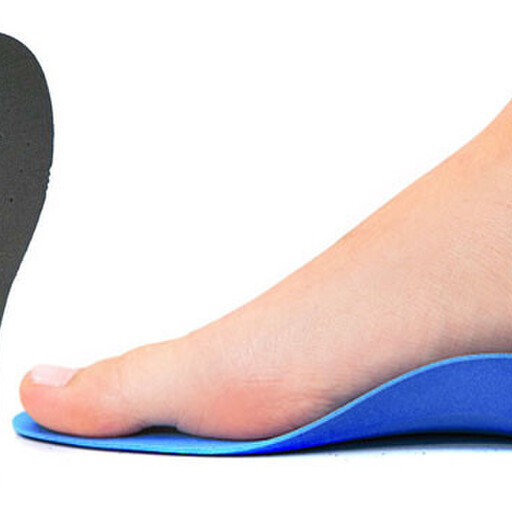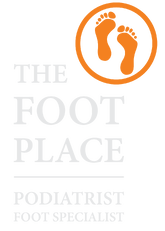Orthotics, orthoses, insole, inner soles, inserts
Foot orthotics are shoe inserts designed to support, align, or improve the function of the foot, ankle, knee and hip. In fact, they help align the entire skeletal system.
In general terms there are two types of orthotics:
Pre-fabricated or “off the shelf” pre-made orthotics - which are often soft and designed to fit the “average” foot shape, and
Prescription orthotics - which are custom-made to fit your foot shape and exact foot requirements.
People of all ages with a variety of foot or lower leg problems wear orthotics. People, with specific foot, knee, hip or spinal problems often utilise prescription orthotics that are prescribed by a podiatrist to help resolve their symptoms by addressing the way their feet move when walking, running, cycling, skiing etc.
Orthotics help to reduce the abnormal movements and loading within the foot. The foot can often move excessively and sometimes in the wrong direction, causing bone and soft tissue injury.
In basic terms, orthotics try to match the unique curvature of the bottom of the foot down to the flat surface of the ground (or within your footwear). In other words, filling the gap between the unique shape of your foot to the flat surface of the ground.
The closer the match, the better the control. The firmer, more stable the orthotics, the better it is able to control your foot movements.
The challenge is being able to make a firm orthotic that is comfortable. This is where we can help.
Signs & Symptoms
3 out of 5 people will develop foot pain during their lifetime. Not surprising when you consider how much work your feet have to endure during an average day. The average, moderately active person takes around 7,500 steps per day. If you maintain that daily average and live until 80 years of age, you will have walked about 216,262,500 steps in your lifetime and an average of 12.5 tonnes of impact every kilometre you walk. Patients' foot and lower limb disorders are commonly related to biomechanical abnormalities, e.g. the way in which the foot, lower limb and body move during activity.
When you stand on your foot, “ground reaction forces” cause “compensatory movements” that can often cause excessive mechanical stress, resulting in tissue damage, inflammation and pain. Bony, cartilaginous, soft tissue - including muscular, epidermal, fascial, tendon, ligament, joint capsule, vascular and nerve tissue can all be affected. Musculoskeletal, neurological and vascular structures can also be influenced or affected by this movement.
Orthotics reduce this abnormal movement and in doing so, reduce tissue damage, inflammation and pain.
Causes
You inherit your foot shape and the way in which it moves under load. Patients with bio-mechanical foot, knee and hip problems will often mention that their mother, father or grandparent had the same issue. Numerous other factors can also produce pathological changes in foot structure and function. These include, but are not limited to:
Systemic disorders, e.g. diabetes,
Charcot Marie tooth disease,
Inflammatory disorders (rheumatoid arthritis),
Infection (osteomyelitis),
Trauma (misaligned fractures, non-reduced surgical correction),
Neurological injury (cerebral vascular incident/stroke),
Head injury
Diagnosis
Podiatrists are primary health care practitioners and can offer diagnoses for disorders of the foot and lower limb, dealing not only with diagnosis and treatment but also prevention and rehabilitation.
When prescribing orthotics, we provide a comprehensive service to ensure safe and effective treatment which includes:
Clinical assessment of your foot problem before the prescription
Prescription for orthotics that are tailored to your individual needs
Advice regarding rehabilitation, exercises and footwear
Follow-up, including initial and ongoing treatment plan
Fine-tuning or correction of any problems experienced while wearing your orthotics.
Treatment
Foot, knee and hip pain can have many causes, some of which can be helped by the use of orthotics.
Much in the same way lenses in a pair of glasses help by “bending the light” as it enters your eye, accommodating your eye shape and enabling you to read or drive a car, orthotics can help accommodate your foot’s structural shape as you use it standing on it, walking, running, cycling, skiing etc.
Orthotics match your unique foot shape to the hard flat ground surface, reducing negative effects of excessively rolling in or rolling out, or in other cases providing off-loading painful pressure points that can produce painful corns or callus.
There are many different kinds of orthotics:
Cushioning orthotics provide cushioning and padding underfoot with shock absorption during walking.
Pressure relief orthotics offer additional relief by redistributing the pressure on problem areas of the foot.
Prescription orthotics offer all these features, plus the benefit of postural realignment. They can also have a longer “life”.
We may prescribe orthotics for your particular foot problem after a comprehensive assessment, taking into account your biomechanics (the way your body moves), footwear, occupation and lifestyle.
Orthotics can provide effective treatment for:
Heel pain/arch pain
Plantar fasciitis
Neuroma (including Morton’s Neuroma)
Corns and Callus
Tendonitis
Recurrent ankle sprain
Stress fractures
Plantar Fasciitis / Arch pain
Aching feet
Painful collapsed arch
Bunion pain
Big toe pain / Sesamoiditis / Hallux Limitus / Hallux Rigidus
Knee pain
Hip pain
Back pain
Neck Pain
Shin splints
Pain in the balls of your feet (Metatarsal pain / Metatarsalgia)
Painful callus formation
Painful corn underneath your feet
Osteoarthritis
Stress Fractures
Neck pain
Fatigue
Mature onset flat feet
Posterior tibial tendon dysfunction (PTTD)
Sinus Tarsi impingement
Subtalar joint pain
Big toe pain
Prevention
It is well recognised that when it comes to your health and your joints, prevention is far better than cure.
Orthotics can reduce the wear and tear on your feet, ankles, knees, hips and spine by reducing the excessive mechanical, physical forces when walking or running on hard flat surfaces.
Orthotics can also be used to help offload painful pressure points at the bottom of your feet. Painful pressure points can develop as we grow older where the normal cushioning at the bottom of our feet (known as fibro-fatty padding) slowly reduces, leaving the bones at the bottom of our feet prominent and vulnerable to excessive pressure from the ground.
The use of pressure-relieving orthotics can also be useful to treat those who may suffer from a reduced blood supply or diabetes; where we need to try and prevent the development of pressure, friction or thermally induced soft tissue injury.
Those patients who enjoy running or walking to keep fit may also benefit from the use of orthotics; reducing their risk of developing a recurring injury that can prevent them from doing what they love to do.
Patients who spend hours on their feet working on hard floors, wearing hard protective boots or gum boots, also benefit from orthotic devices that offer both support and cushioning aimed at providing comfort during and after their working shifts.

